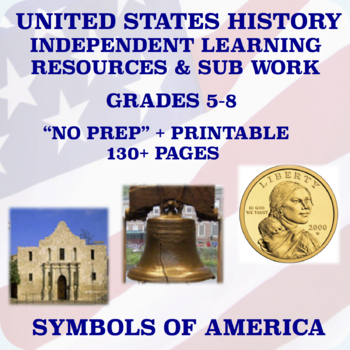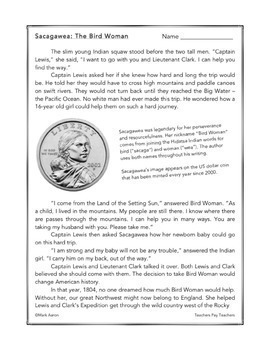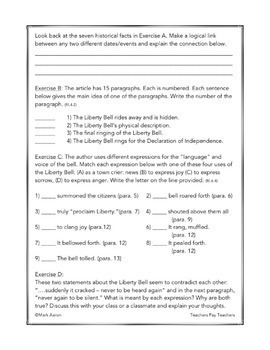Middle School U.S. History "NO PREP" Sub Resources and Independent Assignments
- PDF
What educators are saying
Description
You'll be ready for anything with this self-directed U.S. History learning resource bundle, offering all the help you will need for creating sub plans and a sub binder AND with independent assignments for your U.S. History students!
Are you tired of the last-minute scramble to find meaningful and appealing work or engaging resources for your class? Do you need a quiet day where your students work harder than you do? Are you going to be absent and don't have the time to plan for a sub? Then eliminate the stress now with this creative and easy-to-use "printable/no prep" collection!
Please read the reviews to see what teachers think of this product and how they have used it.
This bundle contains SIXTEEN lengthy, engaging, and unique "print and go/no prep" U.S. History resources AND a great partner/group U.S. History activity that can be easily used by any teacher, whether regular or substitute, or given as individual independent work in a Grade 5-8 US History class.
The sixteen main individual resources in this set involve reading a lengthier U.S. history-based article on an iconic individual, symbol, or event in American history (The Liberty Bell, Sacagawea, The Battle of the Alamo, Lou Gehrig, The Pony Express, Wild Mustangs of North America, George Washington's Mount Vernon, The United States Camel Corps, The Man Behind the Statue of Liberty, The Boston Tea Party, The First Transcontinental Railroad, The Lindbergh Kidnapping, Custer's Last Stand, The Dogs of North America, Annie Oakley: Little Sure Shot, and Geronimo: Apache Leader) and completing Common-Core aligned language and social studies questions afterward.
As an alternative form of assessment and/or for your early finishers, there are also crossword puzzles over key vocabulary, names, and terms for each of the sixteen main resources (with answer keys) provided with this collection!
These sixteen printables, along with the partner/group activity, were created to take about 50-60 minutes each depending on teacher interest in being involved in the reading and require close and attentive reading from the students.
Rest easy while you are gone or enjoy using these resources while you are there, these are interesting and motivating resources that are just what middle school kids need to keep engaged and working in your classroom. NOTE: None of these resources are offered individually or as part of any other collection in my store, they are unique to this bundle!
**This is not "busy work." Students will be completing meaningful and engaging U.S. History work and acquiring new language arts and social studies skills while completing these assignments.**
Included are:
1) U.S. History Reading and Assessment (The Liberty Bell)
An engaging 750-word text on the history and significance of the Liberty Bell, an iconic symbol of America’s freedom for over 250 years. The reading is followed by 22 question created to align with Common Core Standards RI.4.2, RI.5.3, and RI.6.4.
2) U.S. History Reading and Assessment (Sacagawea: The Bird Woman)
An interesting 950-word article on the life of the iconic Native American woman, Sacagawea, who led the Lewis and Clark Expedition safely across America between 1804 and 1806. The reading is followed by 16 questions, each written to align with one of these Common Core Standards: RI.5.2, RI.6.1, RI.6.3, RI.6.7, RH.6-8.1, and RH.6-8.8.
3) U.S. History Reading and Assessment (Remembering the Alamo)
A 1200-word historical account of the prelude to and the events of the famous Battle of the Alamo, which occurred in San Antonio in 1836. The reading is followed by 19 questions written to align with one of these Common Core Standards: RI.6.4, RI.6.5, and RH.6-8.6.
4) U.S. History Reading and Assessment (Lou Gehrig: Man of Courage)
An uplifting 1250-word article on the final years of the most beloved player in baseball history, Lou Gehrig, the “Iron Horse” of the New York Yankees who was struck down at age 37 by A.L.S. (Lou Gehrig’s Disease). The reading is followed by 25 questions aligning with Common Core Standards RI.6.3, RI.6.4, RI.6.5, and RI.6.6.
5) U.S. History Reading and Assessment (The Pony Express)
An 1100-word text giving the historical background and story of the Pony Express, the daring overland mail service which connected East and West for a brief time in 1860-1861 before the telegraph and transcontinental railroad appeared. The reading is followed by 21 questions aligning with Common Core Standards RI.4.5 and RI.6.5.
6) U.S. History Reading and Assessment (The Wild Mustangs of North America)
An interesting 900-word text detailing the rich history of the mustang horses that used to roam the Old West in the millions and which still exist in small numbers today in states like Nevada. The reading is followed by 23 questions of varying difficulty.
7) U.S. History Reading and Assessment (George Washington's Mount Vernon)
An engaging 800-word passage on George Washington and his historic and beautiful home, Mount Vernon. The reading is followed by 22 questions, each written to align with one of these Common Core Standards: RI.4.1, RI.4.5, RI.5.2, and RI.5.5.
8) U.S. History Reading and Assessment (The United States Camel Corps)
An intriguing 950-word article on the fascinating history of the quirky and ambitious U.S. Army experiment known as the “United States Camel Corps", which existed between about 1850 and 1900. The reading is followed by 28 questions, each written to align with one of the following Common Core Standards: RI.4.1, RI.4.5, RI.5.2, and RI.6.5.
9) U.S. History Reading and Assessment (The Man Behind the Statue of Liberty)
An interesting 950-word article on Frédéric-Auguste Bartholdi, the Frenchman who dreamed up, planned, and supervised the construction of the Statue of Liberty in new York Harbor. The reading is followed by 26 questions requiring critical reading of the passage and ranging from recall to analysis and interpretation.
10) U.S. History Reading and Assessment (The Boston Tea Party)
An American history passage of 900+ words called “The Boston Tea Party.” The months of November and December, 1773 are explored in clear order to develop an understanding of what happened and why in Boston Harbor on December 16, 1773. The reading is followed by 27 questions, each written to align with one of the following Common Core Standards: RI.4.5, RI.6.1, RI.6.4, and RH.6-8.8.
11) U.S. History Reading and Assessment (The First Transcontinental Railroad)
A 750-word passage on the building of the Transcontinental Railroad in the 1860s. The text begins with the signing of of the Pacific Railroad Act by Abraham Lincoln and concludes with the driving of the golden spike at Promontory, Utah in 1869. The reading is followed by 23 questions written to align with one of the following Common Core Standards: RI.4.1, RI.4.2, RI.4.5, and RI.4.7.
12) U.S. History Reading and Assessment (America's Ordeal: The Lindbergh Kidnapping)
A detailed 1100-word history passage on the kidnapping of the Lindbergh baby and the investigation that followed. The text follows the events from the March 1, 1932 kidnapping through to the execution of Bruno Hauptmann for first-degree murder in April, 1936. The text examines evidence implicating Hauptmann but also reviews the possibility of his innocence. The reading is followed by 33 questions requiring close reading of the passage and ranging from recall to analysis and interpretation.
13) U.S. History Reading and Assessment (Custer’s Last Stand)
An engaging 1100-word passage on “Custer’s Last Stand” at the Battle of Little Bighorn in 1876. The text explores the events that led up to the battle, the battle itself, and examines theories for why this monumental US Army failure occurred. The article is followed by 32 questions that require close reading and re-reading of the passage and include vocabulary, sequencing, and comprehension activities.
14) U.S. History Reading and Assessment (The Dogs of Native Americans)
An informative 930-word historical passage called “The Dogs of Native Americans.” The passage tells the history of dogs in North America and how they were used for both friendship and hunting by early Native American people. The reading is followed by 25 questions, including vocabulary, text comprehension, and interpretive work that requires close reading of the text. The questions align with Common Core Informational Standards RI.4.1, RI.5.4, and RI.6.3
15) U.S. History Reading and Assessment (Annie Oakley: Little Sure Shot)
An exciting and engaging 1050-word biography on the inspirational and heroic life of Annie Oakley (1860-1926). Annie’s achievements, fame, and talent for shooting as part of Buffalo Bill’s Wild West Show made her America’s most-beloved woman and probably the most famous woman in the world in the early 1900s. The passage is followed by 31 questions that align with Common Core Standards RI.3.8, RI.5.4, and RH.6-8.8
16) U.S. History Reading and Assessment (Geronimo: Apache Leader)
A balanced and informative 900-word biography that tells the full story of Geronimo, the great Apache warrior and leader of the 19th century. The text explains his influence on 19th century American and Native American history. The article is followed by 28 questions, including vocabulary, comprehension, fact and opinion, and interpretive work aligning with Common Core Standards RI.4.1, RI.4.9, RI.5.4 and History Standard RH.6-8.8
17) 50 State Trivia Challenge
A full-period activity for individual students, partner work, or a small group. Students read interesting clues about each of the 50 states and use a United States map to spell the names of the states correctly in an entertaining puzzle format. An extra challenge question at the end completes the activity and makes this entire printable a self-correcting effort!
18) Bonus Vocabulary Activity
Students learn the meaning of 12 common social studies vocabulary terms starting with C: capitalism, case study, chart, citizen, Civil Rights, civilization, colony, communism, compromise, conflict, consumer, and culture. They complete four separate activities to show they understand the terms and definitions.





